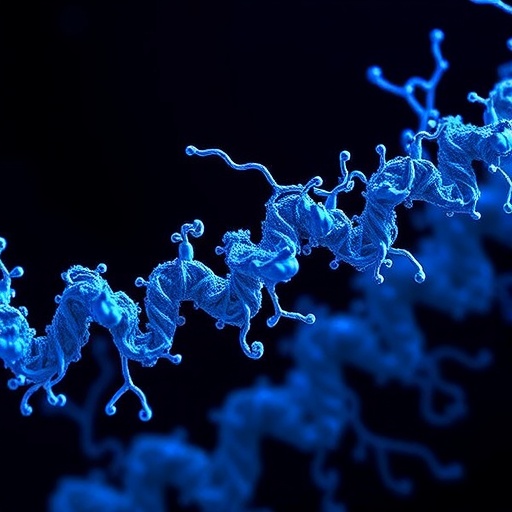The exploration of the mitogenomic architecture of the ant species Mycetophylax conformis has opened up new avenues for understanding the evolutionary biology of the Formicidae family. This comprehensive study, led by Cardoso, D.C., and colleagues, dives deep into the genetic structures that define this insect, providing insight into conserved gene orders and strand asymmetries found within the Myrmicinae subfamily. Their ground-breaking findings reveal not only the complexity of these genetic elements but also their potential implications for the broader understanding of ant phylogenomics.
Ants are among the most diverse and ecologically significant groups of organisms. Their intricate social structures and interactions warrant a detailed understanding of their genetics, particularly regarding their mitochondrial DNA, or mitogenomes. The mitochondrion functions as the powerhouse of the cell, and variations in its genetic architecture can shed light on evolutionary processes. Through their study of Mycetophylax conformis, the researchers are able to identify unique mitogenomic characteristics that may distinguish this ant from others within its lineage.
The methodology employed in examining the mitogenomic structure involved high-throughput sequencing techniques, an approach that allows for rapid and accurate analysis of genetic material. By extracting mitochondrial DNA and sequencing it, researchers gathered robust data on gene order and content. This deep sequencing approach is indispensable for uncovering the hidden genetic diversity within species, particularly in the hyper-diverse groups like the ants. The detailed mapping of the mitogenome illustrates both its coding and non-coding regions, propelling our understanding of the functional aspects of these genetic elements.
One of the significant highlights of this study is the discovery of conserved gene orders across various species within the Myrmicinae subfamily. This conservation hints at a remarkable degree of evolutionary stability, suggesting that specific genetic configurations are maintained due to their integral roles in biological functions. Such findings could inform theories of evolutionary development within the Formicidae family, establishing a foundation for further research into the mechanisms driving genetic conservation and variation.
Moreover, the aspect of strand asymmetry—the unequal distribution of nucleotide composition between the two strands of DNA—was also addressed. The research demonstrated that Mycetophylax conformis exhibits a distinct strand asymmetry, which may influence mitochondrial function and overall metabolism. Strand asymmetry could be a reflection of evolutionary pressures faced by the organism, and understanding these patterns could reveal how ants adapt to their environments over time.
The implications of the study extend beyond mere genetic curiosity. By situating these findings within the context of ecological adaptation, we gain insights into how environmental pressures shape mitochondrial DNA. The unique genetic makeup of Mycetophylax conformis could be reflective of specialized ecological niches. As researchers delve further into the significance of these genetic traits, they may uncover vital links between genetics and adaptations that allow particular species to thrive in specific environments.
As the study progresses, the anticipated applications of this research are exciting. For instance, understanding the genetic underpinnings of ant species can serve as a paradigm for studying other complex organisms. One possible avenue could be synthesizing this knowledge with information on biodiversity and conservation. The insights garnered may help in designing better conservation strategies for ant species, particularly those that are endangered or under ecological threat.
In a broader context, the findings illustrate the interconnectedness of genetic architecture and evolutionary biology. By analyzing mitochondrial genomes, scientists can piece together how species have diverged and adapted over millions of years. This research adds to the building blocks of evolutionary genomics, providing essential data that can refine phylogenetic trees and enhance our understanding of species relationships.
Moreover, this study showcases the importance of collaboration in scientific research. Cardoso, de Lima Baldez, and Vasconcelos exemplify how teamwork can cultivate comprehensive research that advances our understanding of complex biological systems. Their concerted efforts in the lab and field reinforce the significance of interdisciplinary approaches that integrate molecular biology, ecology, and evolutionary theory.
The findings also prompt reflections on the future direction of entomological research. As we continue to unravel the complexities of insect genetics, the implications may extend into agricultural sciences, pest control strategies, and ecological management. The genetic insights gleaned from Mycetophylax conformis could lead to innovative solutions to challenges such as pest resistance and ecosystem balance.
In conclusion, the exploratory research conducted on the mitogenomic architecture of Mycetophylax conformis not only highlights the intricacies of ant genetics but situates this inquiry within the broader scope of evolutionary biology. The discovery of conserved gene order and strand asymmetry in the Myrmicinae subfamily presents a rich tapestry of information for scientists and ecologists alike. As we look to the future, studies like these remind us of the profound connections between genetics, evolution, and ecology, underscoring the importance of continued investigation in these fields.
The study of Mycetophylax conformis is a testament to our relentless pursuit of knowledge about the natural world. Each discovery serves not only as a verse in the narrative of evolution but also as a reminder of the intricate interplay between living organisms and their environments. As the researchers continue to analyze and interpret their findings, the scientific community eagerly anticipates the next chapters that will unfold in the evolving story of ant genetics.
Subject of Research: Mitogenomic architecture of Mycetophylax conformis
Article Title: Mitogenomic Architecture of Mycetophylax conformis (Hymenoptera: Formicidae): Evidence for Conserved Gene Order and Strand Asymmetry in Myrmicinae
Article References:
Cardoso, D.C., de Lima Baldez, B.C., Vasconcelos, H.R. et al. Mitogenomic Architecture of Mycetophylax conformis (Hymenoptera: Formicidae): Evidence for Conserved Gene Order and Strand Asymmetry in Myrmicinae.
Biochem Genet (2025). https://doi.org/10.1007/s10528-025-11278-x
Image Credits: AI Generated
DOI: https://doi.org/10.1007/s10528-025-11278-x
Keywords: Mycetophylax conformis, mitogenomics, Formicidae, evolutionary biology, strand asymmetry, gene conservation, ant genetics, ecological adaptation.
Tags: ant phylogenomics studyconserved gene orders in insectsecological significance of antsevolutionary biology of antsFormicidae family evolutiongenetic analysis methodologies in entomologygenetic structures of Myrmicinae subfamilyhigh-throughput sequencing in geneticsmitochondrial DNA variationsmitogenomic architecture analysisMycetophylax conformis mitochondrial geneticsunique mitogenomic characteristics





